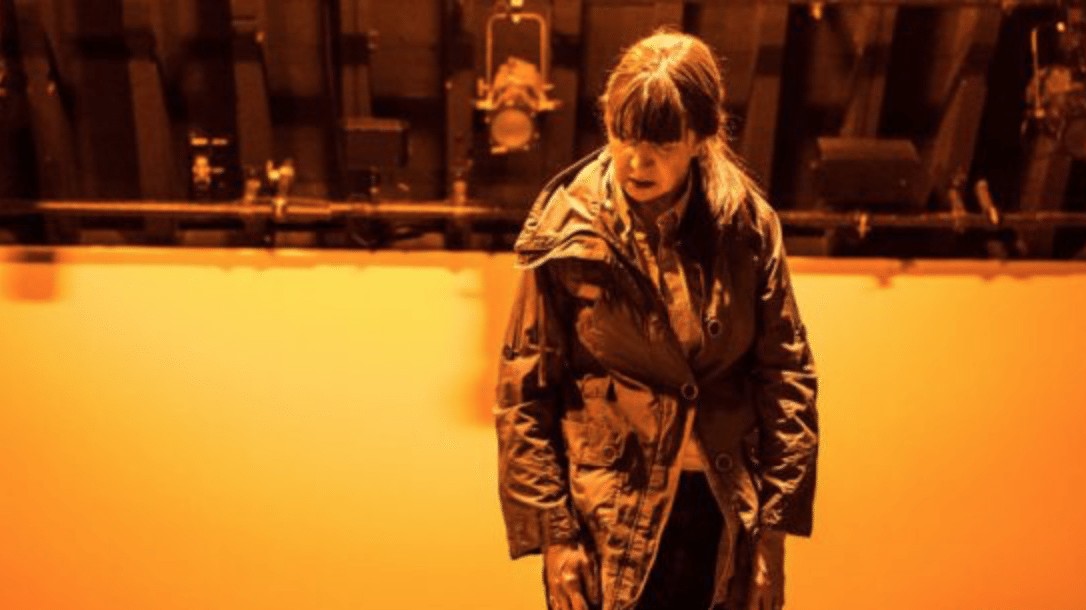
It breathes many breaths, beats as one heart.
Maureen Beattie as the woman appears to be a woman lost. Lost in the circles of people who swirl around her like personified nuclei, lost in her own nuclear reactor and the forces of life it connects her to, but which she can no longer propel or support.
Beattie plays a woman who is not named by playwright Simon Stephens. We don’t find out much about her except that she is suffering a loss and appears to be in an emotional and physical lock down. Life, which is crazed, chaotic, destructive and full of sex, goes on around her regardless as she battles to find some sort of new meaning for herself.
Perhaps the woman’s voice over may help:
“Wind blows over a sandcastle on a beach. It is atomically possible but astronomically improbable that the wind would blow loose sand into the perfect form of a sandcastle.”
The pain here is the woman’s grief at the irreversibility of natural processes and the desire for things to be different, a desire which can only be framed through and initiated by memory and the fantasy that accompanies it to make up for what is not.
The woman’s monologue, relayed to us via loud speaker and already recorded in the past for a future moment (paralleling the asymmetry between future and past) goes on to describe what has to atomically happen for a tea cup to fall to the floor and smash.
The bittersweet irony is that order and things working together cooperate to bring disorder to what was order. Stephens and director Imogen Knight and their collaborators have created a theatre place where entropy reigns supreme.
For starters Chloe Lamford’s design upends domestic units. Nothing is normal or stands the way it should. Everything appears in decline. Enigmatic images are concocted by teacups and biscuits on bricks and un-potted plants in their mess of soil lit by single lamp shades.
Beattie and her posses of four chorus members recline on the upended furniture: at any moment we might expect a sea to flood the Royal Court’s small studio, wiping out all that has been created with a Salvador Dali like majesty.
This does not happen, we are not in a realm full of dream like possibilities, but a world where a woman cannot communicate and in which people wear gas masks and where yellow is everywhere, including in Lee Curran’s light. Yellow is the colour of toxicity.
Because this show’s emotional direction alternates as quickly as that of an electrical current and does not, thankfully, give an audience any idea of how they should respond to it, it is tempting to grab at things half remembered from one’s cultural memory bank in order to impose a frame work or terms of reference.
For me it is Stephens’ interest in folk songs and Knights’ staging of them that gets me thinking about Terence Davies’ films, especially Distant Voices, Still Lives. Knight too is interested in similar song woven tableaus that imply spaces of confinement or trauma and invites the authentic to rub shoulders with the artificial.
Is it a version of this woman’s life that we are being asked to believe in, a version of this woman’s externalised internal where things are both idealised and deprecated that we are being asked to emotionally experience? What is the woman’s proper role in relation to grief and loss, is this also idealised?
Knight’s movement direction consistently undermines the woman’s narrative address as Beattie shows us a heroine struggling against and resisting ideological notions. And when she finally gives in, finally starts to experience the green shoots of feeling, the underground which transports all of life and upon which she travels becomes a Virginia Woolf like Hades: sensory, but oppressive and even disappointing.
The woman talks of moving forward pushed by time’s arrow (although she wants to resist) but Knight has Beattie walk the square boundary of the playing space over and over. A square, which is rigid and unlike the rippling out explosive motion of a circle, cannot go anywhere.
But in time (!) the square Beattie maps out does become the circle, a symbol perhaps of the full circle of orgasmic energy the woman becomes more and more in need of to suspend, if only momentarily, this flight towards death. However, the imagery and movement is shrouded in ambiguity: Beattie is grabbed and almost clawed at by her collaborators as they seem to try to force life into her and accompanied by Peter Rice and Elizabeth Bernholz’s piston like mechanical score which clanks like a factory made heart, we cannot tell if they are demons from hell or saints poised to open the gates of heaven. Perhaps they are both and this is the point- in order to live we have to move forward even as it brings us closer to death. Whatever they are, she wants to both give in and resist, as if caught in the glaring burning nuclear sun between fight or flight.
The fact that Sharon Duncan-Brewster, Gerrome Miller, Beatrice Scirocchi and Andrew Sheridan all wear black and cover their faces also harks back to some sort of nuclear disaster, where its victims, so burned and charred black, are unrecognisable.
There is something instinctual about understanding this piece. The experience of it is immediate, it strikes to the heart in a way that is almost inexplicable. It is ambiguous and agonisingly sad and yet aggressively life affirming. My only issue is that this haunting elegy had to come to an end. I ran out into the underground with a song in my heart though.
until 6th May at the Royal Court
Photo Credit: Maureen Beattie as the woman © Chloe Lamford